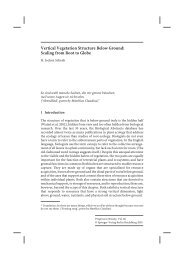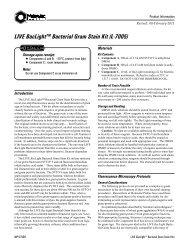Chitons (Mollusca: Polyplacophora) - Biological Science - California ...
Chitons (Mollusca: Polyplacophora) - Biological Science - California ...
Chitons (Mollusca: Polyplacophora) - Biological Science - California ...
Create successful ePaper yourself
Turn your PDF publications into a flip-book with our unique Google optimized e-Paper software.
Vol. XLI(6): 2009 THE FESTIVUS Page 71<br />
from a total of four specimens in the present study that<br />
were collected during trawls conducted as part of the<br />
Southern <strong>California</strong> Bight Pilot Project in 1994. These<br />
chitons occurred at two different sites off San Diego,<br />
which ranged in depth from 43 to 104 m. The maximum<br />
length of the SCB specimens of P. mirabilis is 43 mm<br />
(mean = 24.5 mm), which is rather large compared to<br />
previous records for this species (see Clark, 1994).<br />
Another chiton found with P. mirabilis was Lepidozona<br />
scrobiculata.<br />
Tonicella venusta Clark, 1999<br />
(Plate 8, Figure 21)<br />
Tonicella venusta occurs along the West Coast<br />
from south-central Alaska to Isla Cedros, Baja<br />
<strong>California</strong> from the intertidal to depths of 140 m (Clark,<br />
1999). This chiton is reported here from a single<br />
specimen collected at a depth of 15 m just off of San<br />
Miguel Island, the westernmost of the northern Channel<br />
Islands. It should be noted that this island has a chiton<br />
fauna that is more normally typical of central <strong>California</strong>,<br />
not southern <strong>California</strong>. The chiton was curled with an<br />
estimated length of ~10 mm, which is consistent with<br />
published size records for this species (see Clark, 1999).<br />
This specimen of T. venusta was found living with<br />
Dendrochiton thamnoporus on a rock covered with a<br />
flat, encrusting red coralline alga (~Lithothamnion) that<br />
was brought up in the jaws of a benthic grab (D. B.<br />
Cadien, personal communication).<br />
Discussion<br />
The present study brings to 16 the number of<br />
described chiton species known to occur along the<br />
continental shelf and upper slope of the Southern<br />
<strong>California</strong> Bight (SCB) in waters mostly deeper than 30 m<br />
based on collections provided by benthic monitoring<br />
programs in the region, plus three provisional species as<br />
well as a fourth possibly undescribed species (see Tables<br />
1 and 2). Of the two extant chiton lineages,<br />
Lepidopleurida is represented only by Leptochitonidae<br />
(3 species), while Chitonida is represented by Chitonina:<br />
Ischnochitonidae (6 described and 3 provisional species)<br />
and Acanthochitonina: Mopaliidae (7 species).<br />
Seventeen other species are also likely to occur based on<br />
published bathymetric and geographic distributions (see<br />
Table 1 and below), which brings the region’s estimated<br />
chiton fauna for these deeper waters to about 36 species.<br />
In contrast, Eernisse (1998) reported only six species in<br />
material collected in a survey of relatively deep waters<br />
(50-250 m) of the Santa Maria Basin and Western Santa<br />
Barbara Channel (all also sampled here), but he<br />
cautioned that these were limited samples with at least<br />
another 13 species likely to occur in the region (i.e., 19<br />
species total), probably living in rockier bottoms than<br />
generally sampled in this study.<br />
It is notable that although the total number of<br />
chiton species is relatively high in the SCB benthos,<br />
only three of about 12 total extant taxa typically ranked<br />
at a family level worldwide are present and the diversity<br />
of genera within these three families is not impressive.<br />
The genera that are most diverse are also the most<br />
diverse in the northern Pacific. This is similar to chitons<br />
living in shallow waters along the West Coast, where<br />
higher-level taxonomic diversity is low but certain<br />
genera (e.g., Cyanoplax, Lepidozona, Mopalia, Tonicella)<br />
are either exclusively northern Pacific or else are by far<br />
most diverse there. Our review thus supports the general<br />
pattern that both the shallow and moderately deep fauna<br />
of the northern Pacific has both a high degree of<br />
endemism, with relatively few higher taxa present, but<br />
those taxa that are present are impressively species-rich.<br />
The general lack of overlap between the chiton<br />
fauna above or below about 30 m depth has implications<br />
for the extent of population connectivity of cooler water<br />
“northern” species that so far have not been reported in<br />
shallow water off southern <strong>California</strong>. These have been<br />
found in shallow water from especially the coolest sides<br />
of the northern and western Channel Islands, and also<br />
from the intertidal of known upwelling sites south of<br />
Punta Banda, northern Baja <strong>California</strong>, in the<br />
southernmost SCB. Are these apparently disjunct<br />
populations actually connected to central <strong>California</strong><br />
through individuals living at depths > 30 m off<br />
mainland southern <strong>California</strong>? Our results suggest not.<br />
Assuming that these species have not merely been<br />
overlooked in shallower water along southern <strong>California</strong><br />
shores, we propose that it is more likely that population<br />
connectivity, if it occurs at all, must be the result of<br />
relatively long-distance dispersion of larvae from central<br />
<strong>California</strong>. Given the predominantly warm nature of any<br />
return currents to central <strong>California</strong> via the Davidson<br />
countercurrent, and the relatively rare occurrence of such<br />
southern “refugia,” it could be much less likely that<br />
planktonic larvae from southern disjunct “cool water”<br />
populations could be expected to recruit back to central<br />
<strong>California</strong>. The existence of such “peripheral isolate”<br />
shallow water southern populations could reflect ongoing<br />
processes of genetic isolation that could be producing<br />
incipient species. This opportunity for speciation,<br />
combined with climate-related latitudinal shifts over<br />
geological time, could help explain the high diversity of<br />
certain species-rich genera in the shallow waters of the
















